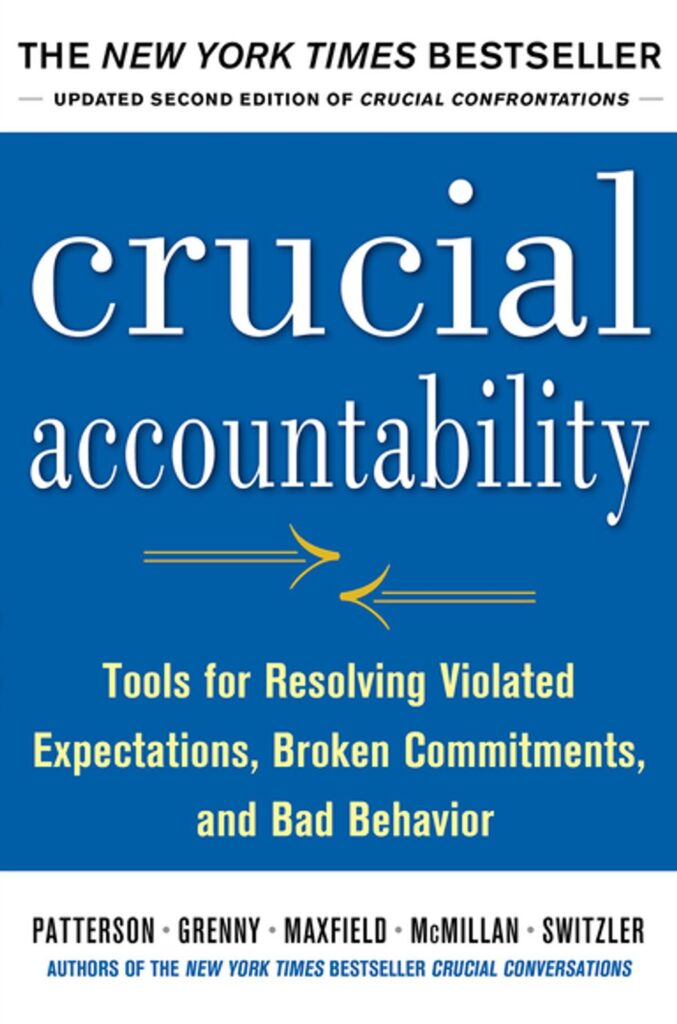Sharing my learnings from the book, Crucial Accountability by Kerry Patterson, Joseph Grenny, Ron McMillan, Al Switzler and David Maxfield
Crucial Accountability by Kerry Patterson, Joseph Grenny, Ron McMillan, Al Switzler and David Maxfield
Accountability marks the difference between healthy and unhealthy relationships and organizations. As people improve in their ability to hold one another accountable, they also improve trust, efficiency, engagement, and performance.

- day in and day out, people around the world are disappointed by others who fail to keep promises or meet expectations. When this happens, you’re presented with a choice: speak up and hold the person accountable or suffer in disappointed silence. Unfortunately, most people opt for the latter simply because they don’t know what to do, or they’re scared of creating a bigger problem.
- accountability issues are rarely simple and straightforward. They tend to come in complicated bundles. Before holding an accountability discussion, it’s important to identify the various problems and decide which is most important to you. To do this, think CPR – content, pattern and relationship. In addition to considering CPR, we need to think of consequences and intentions.
- there are many clues that your accountability issue should be addressed. If you feel hostile towards the other person, you should definitely bring the issue up. Ditto if your conscience is nagging you. If you’re avoiding the conversation because you feel helpless or fear making things worse, this too is an indication that you should speak up
- create the right climate for an accountability discussion by avoiding assumptions. By considering that various personal, social or structural factors may lead to an accountability issue, we avoid creating negative stories. This, in turn, helps us approach the conversation not with assumptions but with the curiosity needed to uncover the reasons behind people’s actions
- make others feel safe by showing respect and establishing a shared purpose
- it’s on you, the person bringing up the problem, to create a safe climate for the discussion
- there are two main things that contribute to feelings of unsafety during an accountability conversation. First is a lack of respect, which comes across in tone, delivery and body language. The second is a disregard for the other person’s goals and interests.
- additionally, you can use a tactic called contrasting. This means anticipating any wrong conclusions that might surface, reassuring people that this isn’t what you mean and clarifying your actual intentions
- establishing a shared purpose works in a similar way. It’s important to immediately let the other person know that the goal of the discussion is to improve things for both parties.
- once you’ve established mutual goals and respect, you can describe the infraction. To do this successfully, lead with facts, not accusations or conclusions. Explain the gap between what you expected and what actually happened. Then add your conclusions, using tentative phrases like, “I thought” and “I was wondering”. Such language signals that your conclusions could be wrong and you’re interested in the other person’s take. And to ensure that you hear the other side, end with a question. Asking something like “what happened” creates a dialogue that helps you solve the problem together
- when discussing an accountability issue, point out consequences can motivate people to do better in the future. If discussing natural consequences doesn’t lead a change in the person’s behavior, create a workaround for the problem and explain it clearly. Sharing your coping strategy makes the other person aware of the cause and effect associated with their behavior. This immediate consequence can motivate a change
- sometimes, accountability discussions reveal that there are barriers stopping people from meeting expectations. When this happens, turn your attention to removing those barriers so they can get their job done. But you don’t have to tackle this alone. In fact, involving others is an important step, one that helps you understand obstacles from the perspective of those closest to them. And when people contribute to finding solutions, they’re more committed to implementing them
- focus here is on empowering others and hearing their ideas about solution, so don’t rush to tell them what you think first. Ask for their ideas and add your own thoughts only if necessary
- keeping the tone upbeat and the climate safe encourages the other party to talk openly about the task
- discuss every barrier you can think of and agree on solutions together. Your goal is to make sure that any obstacles affecting one’s ability are removed once and for all, while empowering them to meet future expectations
- stay flexible enough to handle unexpected challenges
- if we don’t end accountability conversations by establishing and committing to a plan, the resolution is open to everyone’s different interpretations. And so the same problem is likely to occur again and again
- how to create an effective plan:
- focus on The Who, what and when
- any questions about deadlines or task details should be raised and addressed during the conversation to avoid confusion
- when choosing a follow-up method, we need to consider the importance of the task along with the skills and trustworthiness of the responsible parties.
- once all the details of the plan have been hashed out, all the people involved need to commit to it.


Leave a Reply